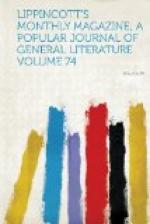“But the lower part of the glasses becomes dark with deposited carbon,” returned the chemist. “If carbons could be made to last long enough to render the lamps cheap, this smoking of the globes would set a limit at which the lamps would cease to be presentable; and the cleaning, and the exhausting of air again, are difficult and expensive.”
“That remains to be proved. But coal is sure to grow dearer.”
“That isn’t likely within a century. Besides, by the fault of the consumer gas-light costs now one-third more than it should for the same light. The best English authorities state this to be the case in Great Britain, and I have no question that such is the fact here.”
“How would you remedy the evil of waste?”
“By the use of economical burners and of governors to regulate the flow of gas.”
“That is very easily said. What is the name of your economical burner?”
“I am not an advocate of any special burner, but of all that are constructed on right principles.”
“There are many kinds of burners. Do you not have some classification for them?” inquired the young lady, who was fresh from Wellesley.
“The usual forms of the burner,” replied the chemist “—or, more properly, the forms of the tip—are the fishtail, the batwing and the argand. In the first the gas issues through two holes which come together at the top, so that the two jets of gas impinge and form a flat flame; in the batwing the gas issues in a thin sheet through a slit in a hollow knob; while in the argand the gas enters a short cylinder or broad ring, escaping thence through numerous holes at the upper edge. There are many varieties of each of these, differing in the construction of the part below the tip. The argand has long been the favorite burner for the table and desk. Its advantages are a strong, steady light, but, as you know, it is apt to smoke at every slight increase in the pressure of the gas, though there are recent improved forms in which this fault is in a measure corrected. A properly-made argand burner will give a light equal to three whole candles (spermaceti, of the standard size and quality) for every foot of gas burned. Of the argand burners, Guise’s shadowless argand has been considered the best, but of late years Sugg’s Letheby burner has carried off the palm. Wood’s burner has been a favorite, as, being a fishtail, it could be used with a short chimney, which gives the flame steadiness. By the arms on the chimney-frame the flame is broadened at the bottom, with a smaller dark space at the base than in any other flat-flame burner. It is so constructed that the quantity of gas passing is regulated by turning a tap in the lower part of the burner, which changes the size of the orifice in the tube. Ten years ago this burner, with a regulator at the meter, was generally thought to be the most economical contrivance possible. It is now little used. Yet either the batwing or the fishtail tip can be used in any common burner except the argand. The old brass and iron tips are mostly superseded by those of “lava,” being liable to an early change of the orifice from incrustation and rust. In the flat-flame burners there are differences in the internal arrangement. Perhaps our young gas-manufacturer here can tell us what is now the most approved burner.”




